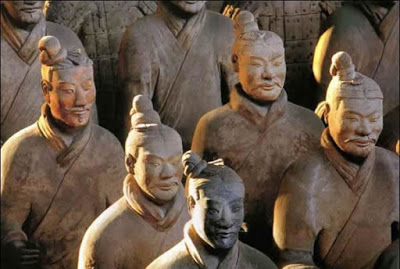Introduction
This article explores the origin of the ancient Tai culture practised by the Lac Viet people in North Vietnam, Guangdong and Guangxi provinces in Southeast China.The Lac Viet has been identified as a branch of the Tai people and ancient Lac Viet culture is different from ancient Han Chinese culture in several ways. The Chinese called this culture literally as 'bun hair at the neck' and 'walk barefoot' from the history book in the Han dynasty《後漢書‧南蠻傳》.
Bronze drums
Around 7th century BC, bronze drums were invented along the Pearl River basin in Guangdong province before the arrival of Han Chinese. A unique characteristic of these bronze drums which were different from Han Chinese drums were the frogs crafted on the side and a symbol of the sun in the center. Frogs are worshipped in some Zhuang festivals. |
| Bronze drums and frogs (right) |
Head
Ancient Han Chinese don't cut their hair at all as they believe that these are given by their parents whereas Lac Viet people do cut their hair short. Ancient Han Chinese men bundle their hair in a knot on top whereas Lac Viet bundled their hair near the neck. |
| Lac Viet - bundled hair at the back near neck |
 |
| Han Chinese - bundled hair on top |
Body
Another unique characteristic of Lac Viet culture is that their men tatoo their body. Ancient Han Chinese don't tattoo their body as they deem it as sacred.Ethnic Zhuang fishermen first tattoo their body with crocodiles to camouflage themselves so that they don't fall prey to crocodiles. Much later, different tattoo designs were used to distinguish one Tai tribe from another Tai tribe.
 |
| Crocodile tattoo |
Feet
Ancient Han Chinese men wore shoes when working outside whereas ancient Lac Viet people usually walked barefoot when working or farming.
The ancient Chinese observed the crooked toes of their bare feet and gave the name Giao-Chi which literally means 'crossed-toe' to the native Vietnamese people.
During the Han dynasty, the Chinese named the region in south-eastern China as Giao Châu in Vietnamese aka Jiaozhou (交州) in Mandarin. Giao (交) is a shortened form of Giao-Chi to represent the natives and Chau (州) means state or administrative division.
This ancient province included modern-day North Vietnam, Guangdong and Guangxi provinces. Its capital was in Guangxin (廣信) city which is the old name for modern day Wuzhou (梧州) city in Guangxi province.
Giao Chi aka Jiaozhi (交趾) in the region of Red River delta was a commandery under this ancient province.
Stilt houses
Another unique characteristic of the Lac Viet and all other Tai people are that the floor of their houses are built on stilts rather than on the ground. In contrast, the ancient Han Chinese built their houses with the floor firmly on the ground. |
| Stilt house |
Giao Chau province
During the Han dynasty, the Chinese named the region in south-eastern China as Giao Châu in Vietnamese aka Jiaozhou (交州) in Mandarin. Giao (交) is a shortened form of Giao-Chi to represent the natives and Chau (州) means state or administrative division.This ancient province included modern-day North Vietnam, Guangdong and Guangxi provinces. Its capital was in Guangxin (廣信) city which is the old name for modern day Wuzhou (梧州) city in Guangxi province.
Giao Chi aka Jiaozhi (交趾) in the region of Red River delta was a commandery under this ancient province.
 |
| Map of Giao Chau during Han dynasty |
In 226 AD (The Three Kingdoms), Giao Chau was split into two smaller provinces which were Guangzhou and Jiaozhou (aka Giao Chau). The smaller Giao Chau province included North Vietnam and south-eastern Guangxi. Its capital was situated in Long Bien (龍編) which is the old name for modern day Hanoi.
 |
| Map of Giao Chau during Jin dynasty |
Conclusion
The name Giao Chau aka Jiaozhou was given to the province due to one of the cultural differences between the ancient Tai people and the Han Chinese. There are other cultural differences such as hairstyle, body tattoo, bronze drums and house style.
These elements provide further proof that the natives of northern Vietnam are the Tai people and NOT the Austro-asiatic people as commonly mistaken.
The modern culture in Thailand is of Mon-Khmer origin and not Tai origin. Furthermore, the modern culture of Vietnamese Kinh is of Han Chinese origin and also not Tai origin.
http://eastasiaorigin.blogspot.my/2017/12/ethnic-origin-of-zhuang.html
Copyright © eastasiaorigin.blogspot 2020. All rights reserved.
The modern culture in Thailand is of Mon-Khmer origin and not Tai origin. Furthermore, the modern culture of Vietnamese Kinh is of Han Chinese origin and also not Tai origin.
Related links
Ethnic origin of Zhuang (Lac Viet)http://eastasiaorigin.blogspot.my/2017/12/ethnic-origin-of-zhuang.html
Sources
- http://www.china.org.cn/english/features/EthnicGroups/136962.htm
- Eastern Han dynasty: southern barbarian.《後漢書‧南蠻傳》
- https://kknews.cc/news/zaxq3vp.html
- https://kknews.cc/culture/2v2va4g.html
Copyright © eastasiaorigin.blogspot 2020. All rights reserved.

Comments
Post a Comment